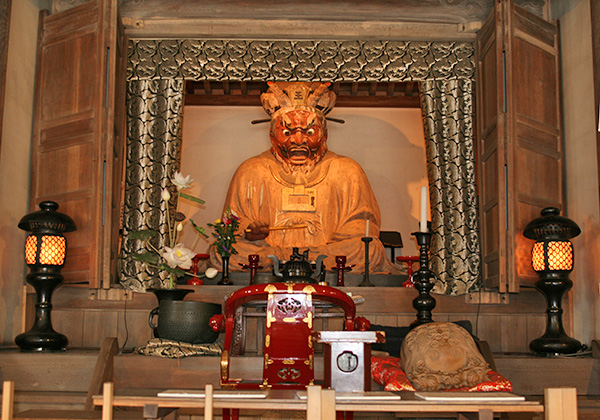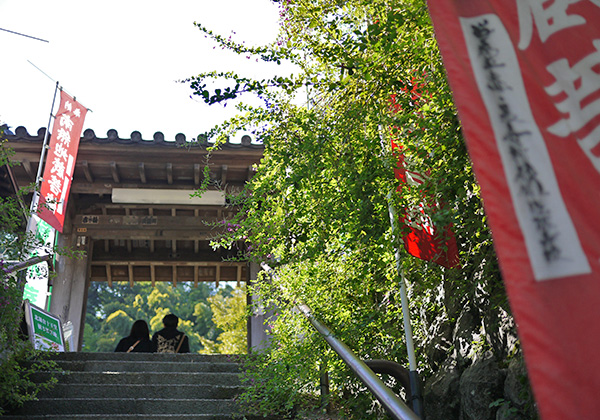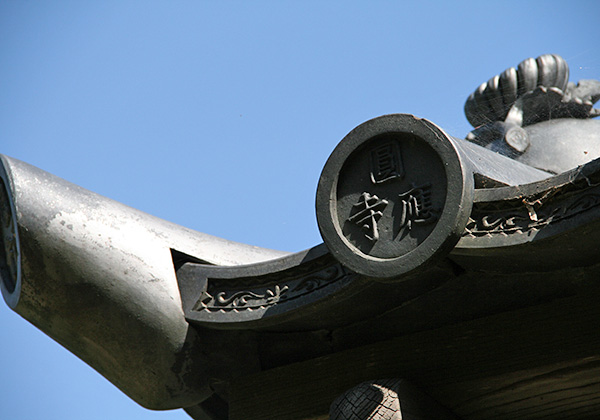Ennoji
| Official Name | Araizan Ennoji {Pronounced ah-rye-zan en-noh-gee} |
|---|---|
| Religious sect | Kenchoji School, Rinzai (Zen) Sect, Buddhism |
| Founded | in 1250 by Unknown |
| Founding priest | Dokai Soden {doh-kye soh-den}, a.k.a. Chigaku {chee-gah-koo} the Zen Master |
| Main object of worship | Statue of Enma-Daio {en-mah-dye-oh} (Judge of Souls) |
| Address | 1543 Yamanouchi, Kamakura, Kanagawa 247-0062 (show route from current location ) |
| Location | Halfway between Kita-Kamakura and Kamakura Station |
| Time needed to get there | 18 minutes from Kita-Kamakura Station or Kamakura Station |
| Admission | JPY300 |
| Open | Mar to Nov 9:00-16:00 Dec to Feb 9:00-15:30 |
| Phone number | 0467-25-1095 |
| Restrooms | Not available |
Historical Overview
Some historians cast a doubt if the Temple was really erected in 1250, because Priest Soden (?-1309) passed away nearly 60 years after the Temple foundation. But the Temple believes it was. Originally located near the Zaimokuza beach, it was destroyed by the earthquake and the tsunami wave in 1703, and forced to move to the present site. Inside the main hall are magnificent twelve statues enthroned on the alter in the shape of letter U.
The Temple is famous for preserving statues of Juo {jew-o} or Ten Kings in Hades. Before worshipping and watching the statues, visitors may need to know a little about the Juo concept. It was based on Chinese Taoism and introduced into Japanese Buddhism during the Heian Period (794-1185) . In Kamakura, it flourished in the 14th century, and it seems to be a Buddhist version of the Roman Catholic's Purgatory or Dante's Inferno. According to the teaching, a wicked man goes to hell after death while a good man to heaven. Those who are not certain will be subject to trial once a week after death on their deeds while they were alive by the Ten Kings over the courts of justice in the netherworld. The trial will be staged by each king on the specific day in the following order:
1. First 7th day after the funeral-------------Shinko-o {shin-koh-o}
2. Second 7th (14th) day after the funeral-----Shoko-o {sho-koh-o}
3. Third 7th (21st) day after the funeral-------Sotai-o {soh-tie-o}
4. Fourth 7th (28th) day after the funeral------Gokan-o {go-kan-o}
5. Fifth 7th (35th) day after the funeral--------Enma Daio {en-mah dye-o} or Yama in Sanskrit
6. Sixth 7th (42nd) day after the funeral-------Henjo-o {hen-joe-o}
7. Taizan-o {tie-zan-o}
8. 100th day after the funeral---------------Byodo-o {byo-doh-o}
9. First Anniversary-----------------------Toshi-o {toh-she-o}
10. Second Anniversary---------------------Godo-tenrin-o {go-doh ten-rin-o}
Enma Daio or Yama, as the ruling judge, brings in a verdict five weeks after one's death hearing the check-ups made by the first four kings. Thereby, the defendants are ordered to go to one of the Six Stages of the World: Hell, World of Preta (hungry ghost), Realm of Beasts, World of Asura (fury), Human Being and Heaven. (In Sanskrit, it reads Sad-gati and some Japanese translate it "Six Stages of Existence". All are suffering stages even in the Heaven.) Henjo-o decides specifically which one of the Six Worlds the defendants will be sentenced to go. The world of Human Being, for example, has various types; wealthy or poor, peaceful or violent. Taizan-o gives personal conditions such as span of life and sex etc. During the first 49 days after death, their souls are believed to be wandering where their body used to live and on the 50th day, they go to the stage where they were ordered to. However, those who go to the World of Hell, Preta, Beasts and Asura may be relieved and can go to Heaven later if they stay religious and hold a mass on the 100th day, first and second anniversary of death.




